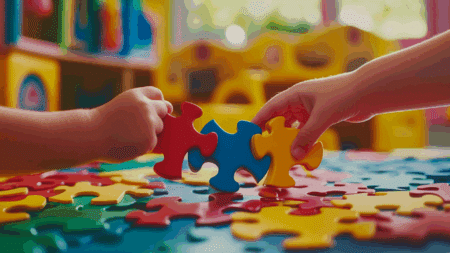“One mitten, two mittens… wait, where did the other one go?” Winter math isn’t just about counting snowflakes. It’s your secret weapon against the “I’m bored” chorus that echoes through homes and classrooms when the temperature drops.
I’ve watched wide-eyed 4-year-olds count ice cubes like treasure and sort colorful mittens with more focus than adults organizing tax documents.
The magic happens when math hides in play—when children don’t realize they’re building essential skills that will serve them for years to come.
These winter preschool math activities aren’t just educational; they’re lifesavers for those long indoor days when the walls start closing in and screen time seems like the only option.
How Winter Math Activities Boost Preschoolers’ Development

Winter preschool math activities work better than regular math practice for preschoolers for several key reasons:
- Hands-on learning sticks: When children count real objects like snowballs or mittens, they grasp number concepts more deeply than with worksheets. The physical experience creates stronger memory connections in developing brains.
- Fun beats boredom: Preschoolers naturally resist sitting still for traditional lessons, but they’ll happily count ice cubes in a melting experiment or sort colored mittens by pairs.
- Multiple skills develop at once: While measuring snow depth, children practice numbers, measurement concepts, and scientific thinking simultaneously.
- Math anxiety prevention: Positive early experiences with math through play help children develop confidence instead of fear around numbers.
- Everyday math connections: Winter activities show children that math is everywhere – in patterns of snowflakes, in the symmetry of paper cutouts, and in the temperature readings on thermometers.
- Sustained attention: Preschoolers typically maintain focus for only 3-5 minutes on worksheet activities but will engage with playful math games for 15-20 minutes or more.
The most effective winter math activities tap into children’s natural curiosity while sneaking in foundational math concepts they’ll build on throughout their education.
Snowy Fun: Winter Math Activities for Preschoolers
Involve preschoolers in fun and interactive winter-themed winter preschool math activities that make learning exciting. Snowy undertakings blend creativity with foundational math skills for a season of educational quests.
Fun with Counting Snowballs

Make counting a frosty fun quest with snowball-themed activities! Preschoolers will enjoy learning numbers and basic math skills while engaging in imaginative snowball counting games
1. Snowball Counting to 10
Use cotton balls or paper snowballs and have children count them into a container. This simple activity encourages number recognition and one-to-one correspondence.
- Required Materials: Cotton balls or paper snowballs, a container
- Ideal Age: 3-5 years
- Math Discipline: Counting
- Math Skills: Number recognition, one-to-one correspondence
2. Snowball Number Match
Match snowball images with numbers to corresponding sets of objects or snowballs with matching numbers. This activity helps reinforce number association.
- Required Materials: Printable snowballs with numbers, objects for counting
- Ideal Age: 3-5 years
- Math Discipline: Number recognition
- Math Skills: Matching, counting
3. Snowball Addition and Subtraction
Start with a set number of snowballs, add or remove them, and then count the new total. This introduces basic addition and subtraction through hands-on learning.
- Required Materials: Cotton balls, number cards
- Ideal Age: 4-5 years
- Math Discipline: Arithmetic
- Math Skills: Addition, subtraction
4. Snowball Hop Counting Game
Lay snowballs on the floor with numbers and have children hop from one to another, saying the number aloud as they land on it. This promotes physical activity while practicing counting.
- Required Materials: Snowball images with numbers, floor space
- Ideal Age: 3-5 years
- Math Discipline: Counting
- Math Skills: Number recognition, physical movement
5. Snowball Roll & Count
Roll a snowball across the floor and count how many rolls it makes before stopping. This activity combines physical movement with counting, helping to reinforce number skills.
- Required Materials: Cotton balls or small balls, space for rolling
- Ideal Age: 3-5 years
- Math Discipline: Counting
- Math Skills: Counting, sequence
6. Snowball Counting with Tongs
Use tongs to pick up and transfer a set number of snowballs from one bowl to another, counting them as they go. This helps develop fine motor skills alongside counting practice.
- Required Materials: Tongs, cotton balls or snowball cutouts, bowls
- Ideal Age: 3-5 years
- Math Discipline: Counting
- Math Skills: Counting, fine motor skills
7. Snowball Number Chart Creation
Create a large snowball chart with numbered spaces. Children place the correct number of snowballs in each space, reinforcing number recognition and one-to-one correspondence.
- Required Materials: Chart paper, snowball cutouts, markers
- Ideal Age: 3-5 years
- Math Discipline: Number recognition
- Math Skills: Number recognition, one-to-one correspondence
8. Snowball Dice Roll Counting
Roll a dice and count out the corresponding number of snowballs, combining number recognition and counting practice.
- Required Materials: Dice, cotton balls, or snowball cutouts
- Ideal Age: 4-5 years
- Math Discipline: Arithmetic
- Math Skills: Counting, number recognition
9. Snowball Sorting by Size
Sort snowballs by size and count how many are in each group. This activity develops skills in sorting, categorization, and counting.
- Required Materials: Cotton balls of different sizes, containers for sorting
- Ideal Age: 3-5 years
- Math Discipline: Sorting
- Math Skills: Sorting, counting, comparison
10. Snowball Patterns
Use different sized or colored snowballs to create patterns, and have the child complete the pattern while counting the snowballs. This helps reinforce pattern recognition and counting.
- Required Materials: Cotton balls or paper snowballs in various sizes/colors
- Ideal Age: 4-5 years
- Math Discipline: Patterns
- Math Skills: Pattern recognition, counting
11. Snowball Counting in a Snowstorm
Scatter snowballs around a space and have kids count how many they can find and collect, simulating a “snowstorm.” This combines counting with physical activity.
- Required Materials: Cotton balls or snowball cutouts, space to scatter
- Ideal Age: 3-5 years
- Math Discipline: Counting
- Math Skills: Counting, number recognition
These activities are structured to be fun and educational while focusing on core math skills for preschoolers. Each one helps build foundational counting and math concepts in a playful, engaging way.
Winter Wonderland Number Recognition

Research number recognition in a winter wonderland setting! Preschoolers will enjoy identifying and matching numbers through festive, snow-inspired activities that make learning feel magical
12. Snowflake Number Matching
Match snowflakes with numbers to corresponding sets of objects or snowflakes with the same number. This activity enhances number recognition and matching skills.
- Required Materials: Snowflake cutouts, number cards or objects to match
- Ideal Age: 3-5 years
- Math Discipline: Number recognition
- Math Skills: Matching, number recognition
13. Snowman Number Counting
Create snowman illustrations with numbered sections and ask children to count the correct number of “buttons” or objects to place on the snowman. This promotes counting and number recognition.
- Required Materials: Snowman images, buttons, or small objects
- Ideal Age: 3-5 years
- Math Discipline: Counting
- Math Skills: Counting, number recognition
14. Winter Wonderland Number Tracing
Provide number tracing sheets with winter-themed decorations like snowflakes or mittens to help preschoolers practice writing numbers.
- Required Materials: Printable number tracing worksheets, crayons or markers
- Ideal Age: 3-5 years
- Math Discipline: Number writing
- Math Skills: Tracing, number recognition
15. Snowball Number Toss
Toss a cotton ball (snowball) into numbered bins or containers and have children call out the number where the snowball lands.
- Required Materials: Cotton balls, numbered bins or containers
- Ideal Age: 3-5 years
- Math Discipline: Number recognition
- Math Skills: Number recognition, counting
16. Snowman Number Order
Print snowman images with numbers on their belly and mix them up. Children arrange the snowmen in numerical order from 1 to 10.
- Required Materials: Snowman printables with numbers
- Ideal Age: 3-5 years
- Math Discipline: Number order
- Math Skills: Ordering numbers
17. Winter Number Bingo
Create bingo cards featuring numbers and winter-themed images. Call out numbers, and children cover the corresponding spaces on their cards.
- Required Materials: Printable bingo cards, markers or buttons
- Ideal Age: 3-5 years
- Math Discipline: Number recognition
- Math Skills: Number recognition, matching
18. Frozen Number Hunt
Freeze number cards inside ice cubes. Have children place the ice cubes in warm water to “melt” and reveal the number cards, identifying the numbers as they find them.
- Required Materials: Ice cube trays, number cards, warm water
- Ideal Age: 3-5 years
- Math Discipline: Number recognition
- Math Skills: Number identification
19. Winter Number Puzzle
Create a number puzzle with winter-themed pieces, such as snowflakes or mittens. Children complete the puzzle by matching the pieces in the correct numerical order.
- Required Materials: Printable puzzle pieces, scissors
- Ideal Age: 3-5 years
- Math Discipline: Number order
- Math Skills: Number recognition, puzzle-solving
20. Snowy Number Stamp Art
Use number stamps to create winter-themed designs on paper. Children stamp the numbers in sequence to reinforce number recognition.
- Required Materials: Number stamps, ink pads, paper
- Ideal Age: 3-5 years
- Math Discipline: Number recognition
- Math Skills: Number recognition, sequencing
21. Winter Number Sorting
Sort winter-themed objects like snowflakes, mittens, or snowballs by their numbers. This activity helps children learn to group items based on numbers.
- Required Materials: Winter-themed objects, number cards
- Ideal Age: 3-5 years
- Math Discipline: Sorting
- Math Skills: Sorting, number recognition
22. Snowball Number Roll
Roll a dice and match the rolled number to snowball images placed on the floor or wall. Children identify and count the snowballs that correspond to the rolled number.
- Required Materials: Dice, snowball images with numbers
- Ideal Age: 3-5 years
- Math Discipline: Number recognition
- Math Skills: Number recognition, counting
23. Winter Number Matching with Sensory Bins
Fill a sensory bin with cotton balls or fake snow, hiding number cards inside. Children dig for and identify the numbers they find in the bin.
- Required Materials: Sensory bin, cotton balls or fake snow, number cards
- Ideal Age: 3-5 years
- Math Discipline: Number recognition
- Math Skills: Number recognition, sensory exploration
24. Winter-Themed Number Wall
Create a number wall with winter-themed decorations like snowflakes. Children place the correct number of objects (such as cotton balls) next to each numbered space on the wall.
- Required Materials: Wall space, number cutouts, cotton balls
- Ideal Age: 3-5 years
- Math Discipline: Number recognition
- Math Skills: Number recognition, counting
Sorting Snowflakes & Creating Color Patterns

Spark creativity and math skills by sorting snowflakes and creating colorful patterns! Preschoolers will enjoy this winter-themed activity that helps develop pattern recognition and sorting abilities.
25. Snowflake Size Sorting
Sort snowflakes by their size, such as small, medium, and large, to help children practice classifying and comparing objects.
- Required Materials: Snowflake cutouts in various sizes
- Ideal Age: 3-5 years
- Math Discipline: Sorting
- Math Skills: Sorting, comparison
26. Snowflake Color Sorting
Sort snowflakes based on different colors, which enhances children’s ability to recognize and categorize various colors.
- Required Materials: Snowflake cutouts in various colors
- Ideal Age: 3-5 years
- Math Discipline: Sorting
- Math Skills: Sorting, color recognition
27. Snowflake Pattern Creation
Create simple repeating patterns using snowflakes of different colors and sizes, reinforcing pattern recognition and sequencing skills.
- Required Materials: Snowflake cutouts in different colors and sizes
- Ideal Age: 3-5 years
- Math Discipline: Patterns
- Math Skills: Pattern creation, sequencing
28. Snowflake Sorting and Counting
Sort and count snowflakes by size or color, combining sorting with counting to help reinforce both skills in a fun, hands-on way.
- Required Materials: Snowflake cutouts, containers
- Ideal Age: 3-5 years
- Math Discipline: Counting, Sorting
- Math Skills: Counting, sorting
29. Symmetry with Snowflakes
Use snowflakes to create symmetrical patterns, helping preschoolers recognize and complete symmetrical designs to develop their spatial awareness.
- Required Materials: Snowflake cutouts, markers
- Ideal Age: 4-5 years
- Math Discipline: Symmetry
- Math Skills: Symmetry, spatial awareness
30. Snowflake Sorting Race
Race against the clock to sort snowflakes into different categories such as size or color, helping children enhance their sorting skills in a timed challenge.
- Required Materials: Snowflake cutouts, timer
- Ideal Age: 3-5 years
- Math Discipline: Sorting
- Math Skills: Sorting, time management
31. Snowflake Graphing
Sort snowflakes by different characteristics and create a bar graph to visually display the sorted data, helping preschoolers understand basic graphing concepts.
- Required Materials: Snowflake cutouts, chart paper, markers
- Ideal Age: 4-5 years
- Math Discipline: Sorting, Graphing
- Math Skills: Sorting, data collection
32. Color-Pattern Snowflake Collage
Create a collage using snowflakes arranged in a color pattern, reinforcing both pattern recognition and creativity.
- Required Materials: Snowflake cutouts, glue, colored paper
- Ideal Age: 3-5 years
- Math Discipline: Patterns
- Math Skills: Pattern creation, creativity
33. Snowflake Pattern Cards
Use pattern cards with snowflakes in varying colors and sizes. Ask the children to complete the patterns by selecting the correct snowflake to match the sequence.
- Required Materials: Pattern cards, snowflake cutouts
- Ideal Age: 3-5 years
- Math Discipline: Patterns
- Math Skills: Pattern recognition, sequencing
Tips for Adapting Activities to Different Skill Levels

Every preschool classroom or playgroup includes children at different stages of math development.
Some might still be learning to count to 5, while others are ready for simple addition. Here’s how to adapt winter math activities to meet each child where they are:
For Beginners (Ages 2-3 or Early Skill Level)
- Simplify counting activities: Focus on numbers 1-5 with larger objects like mittens or paper snowballs.
- Use visual supports: Provide number cards with the corresponding number of dots to help children connect numerals with quantities.
- Emphasize exploration: Let these children simply sort items by color or size without worrying about counting or patterns yet.
- Model language: Use clear, consistent math vocabulary like “more,” “less,” and number words, but don’t expect mastery.
For Developing Learners (Ages 3-4 or Intermediate Skill Level)
- Extend counting range: Work with numbers 1-10 using smaller items like cotton ball “snowballs.”
- Introduce patterns: Create and copy simple AB patterns with winter objects (mitten-hat-mitten-hat).
- Compare quantities: Ask which group has “more” or “fewer” items without expecting exact counting.
- Add measurement concepts: Use non-standard units like paper clips to measure small snowman crafts.
For Advanced Preschoolers (Ages 4-5 or Higher Skill Level)
- Incorporate higher numbers: Count to 20 or beyond with small objects like mini marshmallows.
- Create complex patterns: Move from AB to ABC or AABB patterns with winter items.
- Introduce simple addition/subtraction: “If we have 5 snowballs and make 2 more, how many will we have?”
- Practice estimation: “How many cotton balls do you think will fill this jar?”
General Adaptation Strategies
- Follow the child’s lead: If they show interest in counting beyond what you planned, go with it!
- Use the “challenge and support” approach: Offer the main activity, then have simpler and more advanced versions ready.
- Make it visual: Use picture cards and demonstrations to support children who are still developing verbal skills.
- Pair children strategically: Sometimes, having mixed-ability pairs allows more advanced children to model skills while reinforcing their own understanding.
The goal isn’t perfection but engagement with math concepts. Success looks like children enjoying mathematical thinking, not necessarily getting all the answers right. Adjust your expectations to celebrate progress at every level.
The Bottom Line
Winter preschool math activities convert abstract number concepts into hands-on adventures that preschoolers actually enjoy.
The true power of these activities lies in how they make math feel like play. When children count snowflakes or sort mittens, they’re developing mathematical thinking without even realizing it.
What’s your next step? Start with one simple activity that matches your child’s current interest and skill level. You don’t need fancy materials—just creativity and enthusiasm.
Remember that your attitude toward math matters, too. When you show excitement about these winter math discoveries, you help create positive associations that can last a lifetime.
Stay warm, and keep counting!




